I awaken early with a nightmare. I am at Ofer Prison and the security guards have flushed my clothes down the toilet. I am very freaked out.
News: Today two Palestinians and one Israeli police officer were killed and a Palestinian Israeli MK (member of the Knesset) was shot in the head during a home demolition in the Bedouin village of Umm al-Hiran in the Negev. The Israelis are talking ISIS and terrorism, the Palestinians are saying this is ridiculous, a beloved teacher and father of twelve was killed by the IDF, there was no car ramming, he was shot by the soldiers and lost control of his car. The Bedouin should not be dispossessed from their lands. This is an old story that happens daily. Protests are planned all over the country and in particular at the Clock Tower in Jaffa where I am headed in the afternoon.
https://www.timesofisrael.com/arab-mk-injured-in-violent-clashes-with-police-at-bedouin-village/
First, Ivan Karakashian, advocacy unit coordinator of Defense of Children International Palestine (DCIP), is taking me to that very Ofer Prison, an Israeli military pretrial detention center just outside of Ramallah. This is not a usual stop on the Holy Land tour, but I am particularly interested in military detention and in particular, arrests and detention of Palestinian children and those who are doing the holy work of trying to keep them safe. DCIP consists of an office of three lawyers who handle 140 cases per year. The children are tried in military courts, but one lawyer covers East Jerusalem so he works through the civil courts, because Palestinians in East Jerusalem are technically not under occupation. As we drive from Bethlehem, Ivan explains that children who are convicted serve time at Megiddo which is the only Israeli military prison that has a juvenile section that usually houses 60-70 children at a time. The children are in the care of four adult Palestinian prisoners who are serving long sentences. This arrangement is considered preferable since they are less abusive to the children than the Israeli guards. Of course they have no special training but they have a lot of useful experience surviving in the so called military justice system. The older prisoners accompany the children to the medical clinic or to lodge a complaint. Most of the documented torture happens in the first 24-48 hours after arrest before children actually get to Megiddo.
In prison there is minimal psychosocial support or rehabilitation. The prison provides teachers (Palestinians with Israeli citizenship) who are permitted to teach Arabic, Hebrew, and math. Topics like history and literature are considered too dangerous (ie. potentially political and actually useful) to offer. The children are divided by the teachers’ assessment of their intelligence level and then all the high functioning students of all age groups are grouped together, midlevel together, etc. Unfortunately the education is pretty basic and students who miss more than 30% of the school year at home, (two months), are required to repeat the entire year. Stone throwers on average serve three to twelve months.
Because of the trauma, many children on release do not ever return to school; they feel too adult to be in a classroom with younger students and tend to do vocational training, entering the market place at a young age and easily exploited. Some do continue and Ivan notes that many of the DCIP staff are former prisoners who have law degrees or are human rights activists.
During the sentencing phase, the child may receive a custodial sentence, a fine, or a suspended sentence. The average fine is 1,560 NIS (approximately $390) and if the family is unable to pay, the child receives an additional four weeks of imprisonment for every 1000 NIS. You could call this a money making racket; Palestinian families support the system that imprisons their sons and daughters. The suspended sentence is like a probation period for two to five years during which time if the child commits another crime, he faces significantly more imprisonment. Many of the families are already impoverished, “the children are almost street children,” so this represents significant shekels. The suspended sentence has had an unexpected impact; many children are so afraid of arbitrary arrest, they refuse to leave their homes. “So the children imprison themselves.” Some lawyers argue for longer suspended sentences in order to reduce the length of imprisonment. It’s hard to know what is worse.
DCIP has found that torture and ill treatment of children in Israeli prisons has decreased, but there are more children in prison overall. In February 2016, there were 440 Palestinian children in Israeli military prisons, the highest number since they started collecting statistics in 2008. Approximately 700 children are arrested, prosecuted, and charged per year. Even more are arrested and detained sometimes for up to a week, but not charged.
2016 has also been the deadliest year for child fatalities, 32 dead children from the West Bank and Jerusalem. In 2013 there were five. In 2015 the Israelis reintroduced administrative detention for minors; a policy of detaining people without charge or trial for indefinite periods of time. (think, maybe Guantanamo?) This is legal when a person presents a threat to the security to the state, the “ticking bomb,” but these children have been detained for much less substantial reasons. Five were interrogated about Facebook posts. Then three months later they are released without follow up, so exactly how dangerous can they have been?
Ivan also notes that children are sometimes held in solitary confinement during interrogation before charges are made; this is legally recognized as a form of torture, isolating the accused in order to break them to make a confession. There were 161 cases of child solitary confinement in 2016. The longest a child was held was 26 days; in 2015, 45 days. This is mostly used against 16 and 17 year olds, which brings us to the question, who exactly is a minor? Around 2012, the Israeli military defined a minor as a child less than 18 years of age, although “criminal responsibility” beings at twelve. But sixteen and seventeen year olds who are convicted are sentenced as adults. There is no consistency. This is, after all, military justice. Younger children are detained, harassed, and released, but traumatized nonetheless. Every child in military court has to have a lawyer, but children are denied a lawyer prior to interrogation in 97% of cases. The same numbers apply to access to their parents prior to interrogation. So again, imagine the frightened 14 year old, he may or may not have thrown stones at a passing jeep, maybe his cousin implicates him, he is told to confess, he has faced two days of intense interrogation and psychological pressure, and all he wants is to see his mother and father.
We arrive at Ofer Prison, a large concrete wall topped with barbed wire and guard towers encasing the prison where pretrial hearings are held. Behind the central structure is a maze of caged corridors, turnstiles, and security checkpoints. Ivan advises me to leave my watch, rings, phone, paper, and pen in the car, just bring my passport. My first impression is of the crowd of families waiting to pass security, the fear and fatigue etched on their faces. Some have traveled for many hours to see their loved ones have their moment in court. A loud male voice barks on the speaker, ordering them to back away from the security system. After the metal detector and the x-ray of my coat, I am patted down by a security guard who interestingly, apologizes. Does she apologize to the Muslim mothers and sisters or does she see them as terrorists? She makes me toss out my tissues and cough drops, apparently grave threats to the great State of Israel.
We enter an open cage bordered by metal wiring where family members who have been told by their lawyers that this is the day of the hearing, wait and smoke and pace and wait. They are not given a time for the hearing. The space is bordered by planters with unhappy geraniums that are mostly squashed from people sitting on them. There is no way to make this place beautiful. Periodically an upscale looking lawyer (definitely class distinctions here) comes through and is swarmed by anxious family members. Beyond the turnstile are seven large caravans where the court cases are heard, and clusters of military prosecutors in green, military police in black, and the swanky men and women (ie. lawyers). The mood is mostly bleak and intense, with occasional gallows humor.
Ivan finds a lawyer who agrees to our sitting in on a hearing and we enter one of the caravans and sit in the back. Four young men sit behind a wooden bannister, their legs shackled. Children are also shackled and I am told appear wearing the bulky adult jackets as there are no clothes their size. I try to imagine being a skinny 15 year old in a giant overcoat with shackled legs appearing before the crunch of guards and judge and lawyers, meeting a lawyer for the first time, scared and lonely. One man is also handcuffed when he leaves. The military judge wearing a kippah sits on a raised platform with a stenographer, both pretty much glued to their computers. The military prosecutor, (a young woman with a long pigtail), sits opposite; they are not actual lawyers, but military people trained in military law. In the middle are a cluster of real lawyers and guards that go in and out. The translator is a soldier, often a Druze who serves in the army. There is nothing that resembles a “trial” going on here. No evidence or witnesses are called. Some lawyers know their cases; others are meeting their clients for the first time. There are several groups that provide lawyers, like DCIP, as well as private lawyers and they spend a lot of time striking deals with the judge, negotiating with the prisoners. There are smiles, angry voices, frustration; it all appears pretty chaotic. In minutes, major life decisions are made by the powers that be and the prisoners leave.
We return to the big group cage and talk to some of the families. Some are here for the first time, others have done this trip many times as cases are often postponed. If a family member is unable to attend, the child’s case is postponed. We talk with a girl who was arrested in front of the Ibrahimi Mosque, detained for one day, and released without charges. Basically Palestinian children are guilty until proven innocent. A woman’s son has been in detention for four months on seventeen charges. Ivan explains that charges can range from throwing a stone at the wall, a jeep, a soldier, insulting the honor of a soldier, attending a political protest, to being a member of a political group. The lawyer and the prosecutor could not agree on the plea deal so the case was postponed. Two other women are here for their brother who was arrested four months ago. Initially they couldn’t locate him and they do not know what the charges are. There are no happy stories here. I am mostly struck by how routine and banal this whole process feels. The Israeli military has succeeded in normalizing the arrests, detentions, and imprisonment of children and adults who are resisting an oppressive occupation that is strangling their lives and their futures. And the Palestinians arrested understand that a good day is when a deal can be struck, maybe prison for five rather than ten years, maybe a suspended sentence and huge fine that devastates the family but let’s the guy go home in six months rather than six years. No one asks if children throwing stones at a heavily armed military force is a crime deserving months to years of imprisonment.
I am feeling very weary, watching families waiting, watching the comings and goings through the turnstile, some smiling, some in tears. We return to the car and I ask Ivan about posttraumatic stress disorder (PTSD) in the arrested children. The data is anecdotal, but support is offered through the Palestine Counseling Center and the YMCA Rehabilitation Program. The latter reportedly visits 80% of released children, but there is no referral system and no long term care. “The family fabric provides support and shared experience with older kids, [prison] is seen as a rite of passage.”
Ivan notes that children arrested for crimes like stealing, rape, and murder of another Palestinian are taken to PA prisons and are not celebrated by their communities like those in Israeli jails. They are a source of shame for their families. The Palestine juvenile justice program is improving. In 2016 the Protection Law was created with an emphasis on rehabilitation, reintegration into society, and alternatives to detention, in keeping with international standards. But many in the justice system are unaware of these changes and organizations like DCI and Unicef run capacity building programs to inform those who provide juvenile care. There are now juvenile police officers who treat children well, but arrests are still being made by those ill equipped to do so.
Unfortunately the Israeli military justice system is not a proper legal system according to Ivan. Military commanders issue orders that are added to the rules, but there are no amendments to older conflicting rules; there is no body of case law and precedents on which to build a system. DCI has been working on cases for the International Court of Justice and in two years they will complete their preliminary investigation. It takes up to 15 years to come to a final recommendation so this is very much a long haul kind of effort.
Ivan drives my husband and me to Jerusalem; we take a sherut and then a taxi to Jaffa where we hydrate, shower in lovely hot water, (which aquifer in the West Bank was this water stolen from?) and enjoy the luxuries of a first world double shot espresso. I am having trouble traversing so many worlds in one long afternoon.
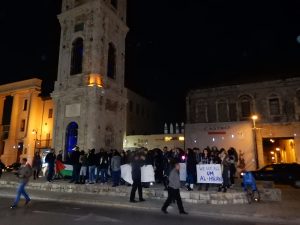
At 7:00 pm we are at the Clock Tower with a group of chanting Palestinians with Israeli citizenship and a scattering of lefty Israeli Jews and children. I spot the Palestinian actress Ruba Blal in the front lines. The crowd grows to almost 100, mostly young Palestinians, and the police presence grows as well. There are undercover agents and several officers tasked with filming the protest and taking photos of each of the participants. People are drawing handmade signs, “We are all Umm al-Hiran,” and the chants are all about freedom from occupation, racism, dispossession, and Israeli domination.
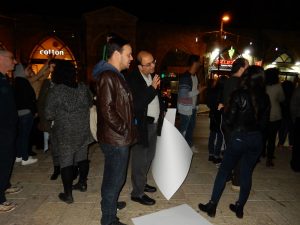
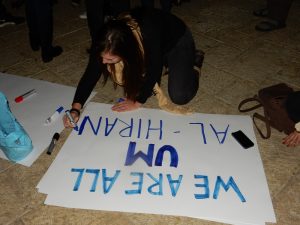
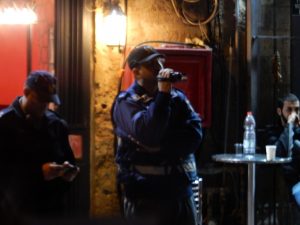 The crowd moves into traffic as the cops begin to converge, but retreat before there is trouble and return to the Clock Tower, apparently this tactic annoys the cops but prevents them from taking control of the demonstration. After an hour, we march into the street, but the demonstrators reach a phalanx of police officers who are clearly creating a barrier. More chanting and tension; we return to the Tower where it all fizzles out.
The crowd moves into traffic as the cops begin to converge, but retreat before there is trouble and return to the Clock Tower, apparently this tactic annoys the cops but prevents them from taking control of the demonstration. After an hour, we march into the street, but the demonstrators reach a phalanx of police officers who are clearly creating a barrier. More chanting and tension; we return to the Tower where it all fizzles out.
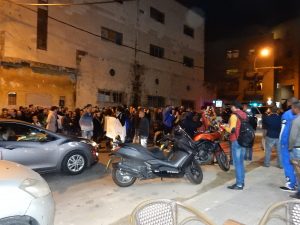
A general strike of the “Arab sector” has been called for tomorrow. An older Jewish Israeli activist notes that the younger Arabs in Jaffa are so brave to demonstrate; they are finding their voice and refuse to be intimated. A longtime Palestinian activist tells me, “We do this for ourselves.” He is not optimistic that the Israeli state is going face its racism and aggression anytime soon.